Americans spent more than they earned. That's what's implied in the BEA's September personal income and outlay's report. Consumer spending increased 0.8% from last month, and when adjusted for inflation was a 0.4% increase for September. Consumer spending is another term for personal consumption expenditures or PCE. Real personal consumption expenditures are hugely important to economic growth as consumer spending is about 71% of GDP. Real means adjusted for inflation.
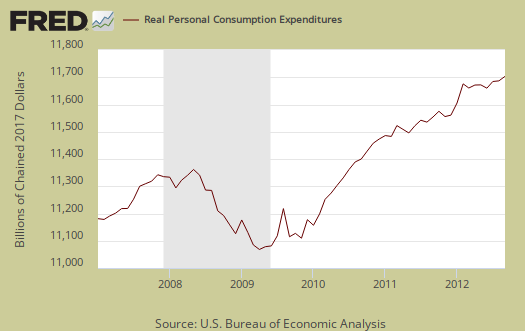
Personal income increased 0.4% as did disposable income. Yet, when adjusted for inflation, actual disposable income had no change, 0.0%. Take away inflation and government payments, personal income decreased -0.1% (see further below). People had less real money to spend in September as was true in August, yet consumed more. Graphed below are the monthly changes for real personal income (bright red), real disposable income (maroon) and real consumer spending (blue).

Below are the real dollar amounts for real personal income (bright red), real disposable income (maroon) and real consumer spending (blue).

Consumer spending encompasses things like housing, health care, food and gas in addition to cars and smartphones. In other words, most of PCE is most about paying for basic living necessities. Graphed below is the overall real PCE monthly percentage change.
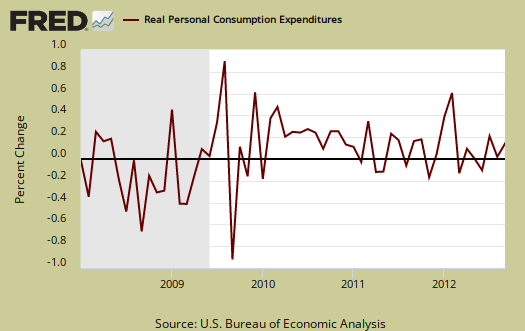
What people spent money on, adjusted for prices, or in real dollars, by monthly percentage change was:
- durable goods: +1.3%
- non-durable goods: +0.5%
- services: +0.2%
Health care, for example, is a service. Gasoline is a nondurable good. Cars are a durable good. Additionally when people are cutting back, durable goods are usually the first things to go, especially large ticket items.
Price indexes are used as divisors to adjust for inflation and price changes. The indexes are used to compute spending and income for an apples to apples, real dollar comparison to previous months and years. Economic statisticians use real dollars so one does not erroneously assume economic growth when it's really inflation.
The PCE price index is used to remove inflation from consumer spending and income, reported above. The price index increased 0.4%, for September and is up 1.7% from a year ago. Energy alone, which includes gasoline, increased 4.8% in a month and last month increased 5.8% and has increased 3.2% from a year ago. Minus energy and food, the price index increased 0.1% and is up 1.6% from this time last year. While the PCE price index represents inflation, it is different from CPI. Food is claimed to have decreased –0.1% for September. Who finds food decreasing when the drought causing prices to soar unbelievable?
While personal income increased 0.4%, these numbers are the total for everybody in the United States who is reported and not part of the underground economy. Below is personal income, not adjusted for inflation, or price changes.
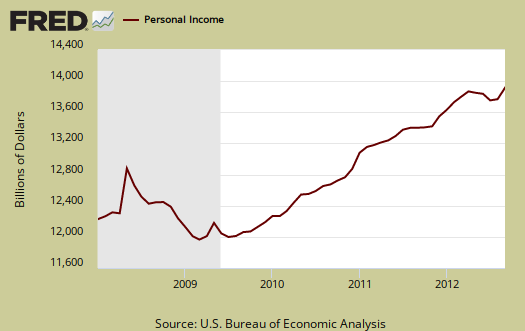
Real personal income, or personal income adjusted for inflation, via the PCE price index, and also has government payments, such as social security, removed, decreased -0.1%. Below is the graph of real personal income.

Why the BEA report doesn't give real personal income monthly changes including transfer receipts, instead of excluding them, I do not know. Below is the monthly percentage change in real personal income, or adjusted for inflation and excluding payments from the government.
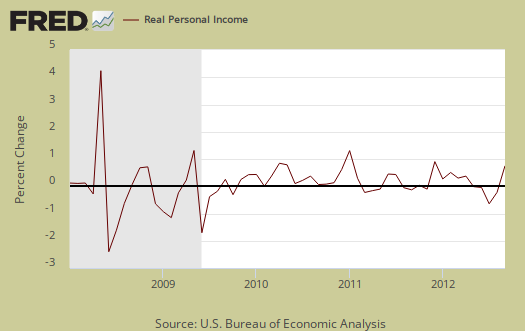
Disposable income is what is left over after taxes. DPI (disposable income), increased 0.4% from last month. DPI adjusted for inflation (see the price indexes above), had no change, from the previous month. These numbers are aggregates, which includes income of the uber-rich, or the 1% of the population, as they are now called.

Below is real disposable income per capita. Per capita means evenly distributed per person and population increases every month. September mid-month the U.S. population was 314,803,000, in increase of 213,000 from last month. In other words, while on aggregate personal income has increased, so has population to earn that income. When taking increased population into account, we basically have no growth in real disposable personal income and this is over years.
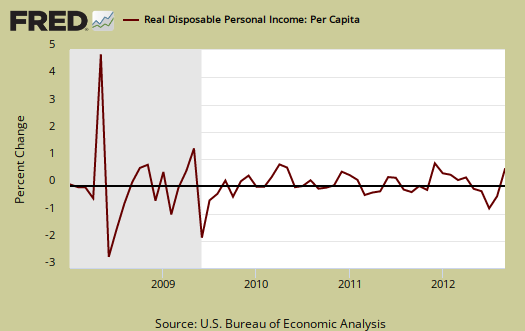
The monthly percentage change for wages and salaries was 0.3% as was total compensation, which includes wages, salaries. Landlords just keep making out like bandits, rental income increased 1.1% in a month and proprietor's total income, with inventory valuation and capital consumption adjustments, increased 1.1%. Personal receipts, income on assets, decreased by -0.3%. This is income from non-incorporated businesses, such as the self-employed. Dividend income increased 0.9% for the month, interest income, -1.2%. Investors win again, savers lose.
Graphed below are wages and salaries for the past decade. Notice the dip and the more flat line than earlier in the decade. Bear in mind these are aggregate, or all wages and salaries, and not adjusted for inflation.
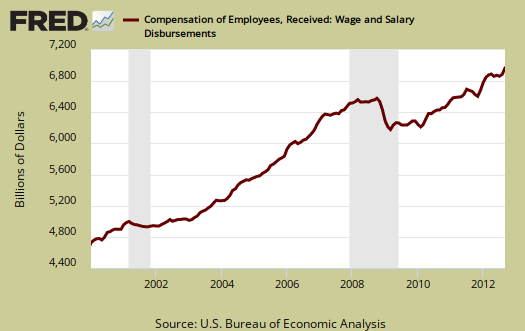
Below is adjusted for inflation personal income minus personal current transfer receipts. This graph shows how much personal income increased that wasn't funded by the government and is used as a recession indicator as show in the below graph with the gray bars indicating recessions. Transfer receipts are payments from the government to individuals where no actual services (work) was performed. This includes social security, unemployment insurance, welfare, veterans benefits, Medicaid, Medicare and so on.

Transfer receipts monthly change was +0.5%, not adjusted for inflation. Below is a graph of just transfer receipts.
Personal current transfer receipts increased $12.7 billion in September, in contrast to a decrease of $1.6 billion in August. Within current transfer receipts, government social benefits to persons for social security benefits increased $14.0 billion, in contrast to a decrease of $2.4 billion.
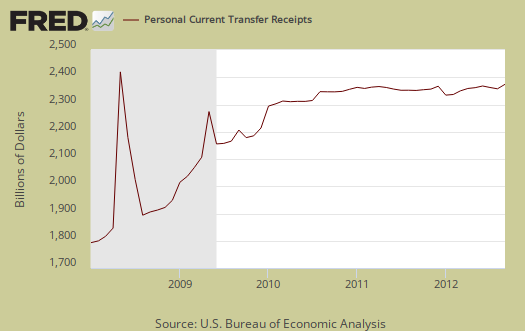
Personal savings is disposable income minus outlays, or consumption and not adjusted for inflation. The Personal Savings Rate was 3.3% in September.

Below is disposable personal income minus personal consumption expenditures monthly raw total changes. When we see this spike we know people are not spending in relationship to the income they have available.
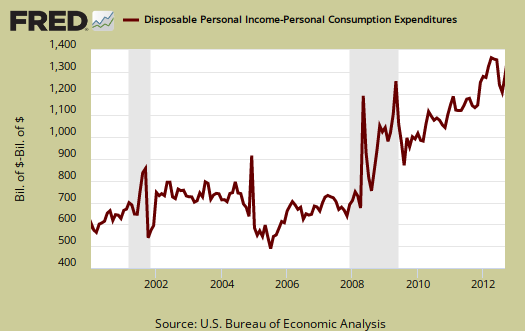
Personal Outlays means what goes out of your pocket and thus into the economy. Personal outlays are PCE, personal interest payments, and personal current transfer payments. PCE is defined above by percentages is almost all of personal outlays. Personal interest payments are things like the interest you pay on your credit card. Personal transfer payments are defined as:
Payments consisting of transfer payments by persons to government and to the rest of the world. Payments to government include donations, fees, and fines paid to Federal, state, and local governments, formerly classified as "personal nontax payments."
In other words, personal transfer payments are nothing more than that speeding ticket you just got or how you just donated to this site. People often confuse transfer payments with transfer receipts, not the same thing.
Taxes collected on person income increased $5.2 billion in September, compared with an increase of $2.5 billion in August. Below is a graph of personal income taxes. Here we can see the effect of the Bush tax cuts as well as the recession (no income, no taxes on that income), as well as the temporary tax breaks from the Stimulus.

To visualize more data from this report, consider playing around with more of the St. Louis Federal Reserve Fred graphs.
Here is our overview from last month and overviews of GDP are here.
This overview details the BEA Personal Income and Outlays statical release, which covers individual income, consumption and savings. The personal income & outlays report is annualized and seasonally adjusted, although most percentages are presented as monthly rates.

Recent comments